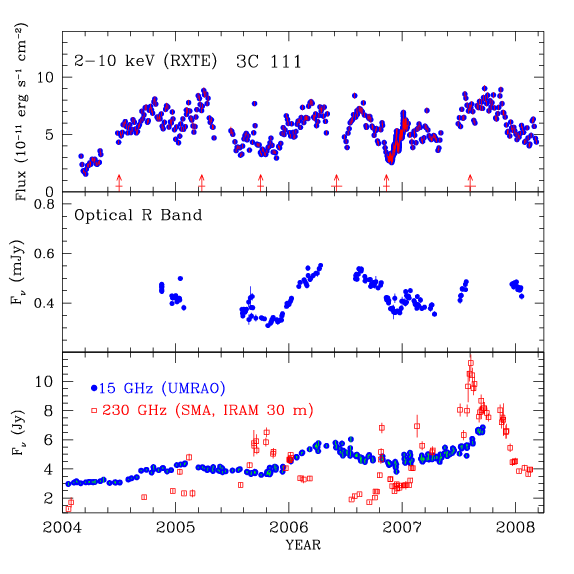
The more powerful (Fanaroff-Riley 2) radio galaxy 3C 111 is a bright source of X-rays. We started monitoring this object with RXTE and the VLBA in March 2004. We were immediately rewarded with a sharp dip in X-ray flux followed by a rise that had started by June and continued through October 2004 before leveling off to roughly the same flux level as previously reported in the literature from data taken in the 1980s and 1990s. A very bright superluminal radio knot started to emerge from the core during the summer, with an extrapolated "birth" date of 1 July 2004. A decrease in flux at the beginning of 2005 by about 40% from the peak preceded the appearance of a bright, but not so dominant, superluminal knot. A dramatic outburst at mm wavelengths occurred during an extended low X-ray flux state, with an elongated (in the direction of the jet) superluminal knot brighter than the core appearing on VLBA images starting in November 2005. Another dip + ejection appears to have occurred in mid-2006, mostly during the sun gap. At the end of 2006, RXTE saw a very pronounced X-ray dip, with a very bright knot appearing near the X-ray minimum. These coincidences notwithstanding, we cannot yet demonstrate statistically that the X-ray dips are associated with the superluminal knots - there is too high a probability that they are chance coincidences. This is accentuated by the very bright superluminal knot and radio outburst during the 2nd half of 2007: any corresponding X-ray dip would have occurred in May-June 2007, just when 3C 111 was too close to the Sun for RXTE to observe it.
Here are the light curves, with red arrows showing the times of ejection of superluminal knots in the 43 GHz VLBA images:

The top panel is the X-ray light curve, the middle panel shows the optical data from the Liverpool Telescope and Lowll Observatory, and the bottom panel shows the radio light curve at 15 GHz from the University of Michigan Radio Astronomy Observatory along with some points from 230 GHz. We will continue to observe 3C 111 with RXTE twice per week until at least December 2008. Among other things, we expect to establish the level of statistical significance of the association between low X-ray brightness and superluminal knot ejections.
As in 3C 120, there is strong evidence that the X-rays come mostly from the accretion disk or its immediate surroundings, close to the black hole. The main indication that this is the case is the presence of an X-ray emission line at a rest energy of about 6.4 keV, as seen in Seyfert galaxies, interpreted as iron K-shell fluorescence when an electron in the innermost shell is knocked out of the atom by an X-ray photon, with another electron in an outer shell jumping down to take its place. According to the main current model, it is caused by X-rays from the corona shining onto the accretion disk. (See the sketch on our research page, top right-hand side.) As in microquasars and 3C 120, for some reason a decrease in the X-ray flux might coincide with extra energy being shot into the jet, appearing some time later as a bright knot moving down the jet.